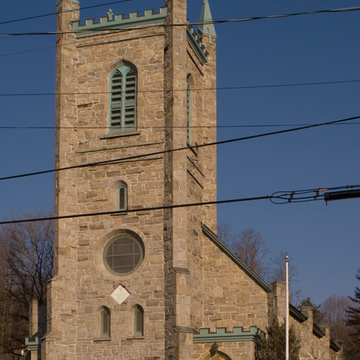This smaller of the two extant churches designed by this Vermont Episcopal bishop and architect is also the more resolved in composition. Begun seven years after Hopkins had consecrated the parish's summer chapel (see RU4), St. Thomas was constructed as its all-season home under the patronage and supervision of John A. Conant (a leading citizen whose 1802 house next door ultimately became its rectory). Built of rock-faced local blue limestone, it is particularly close in design to the later Trinity Episcopal Church in Rutland (RU24). A central square tower is set against a simple nave, all marked by angled and stepped buttresses. Entrance is through two small flanking porches tucked into the reentrant corners beside the tower, which has a rose window illuminating the organ and choir loft. A louvered lancet belfry zone with crenellations and buttress finials provides a dramatic climax. It bears out Hopkins's observation in his Essay on Gothic Architecture (1836), “There is no other style of architecture which admits such variety, which is so beautiful on any scale, and which is so little dependent on size for its effect.” The interior, with stained glass windows from the Doremus firm, hammer-beam ceiling, and oiled butternut wainscoting and furnishings, looks much as it did in the 1890s but for a shift of the original choir stalls and organ to the front of the sanctuary.
You are here
St. Thomas Episcopal Church
If SAH Archipedia has been useful to you, please consider supporting it.
SAH Archipedia tells the story of the United States through its buildings, landscapes, and cities. This freely available resource empowers the public with authoritative knowledge that deepens their understanding and appreciation of the built environment. But the Society of Architectural Historians, which created SAH Archipedia with University of Virginia Press, needs your support to maintain the high-caliber research, writing, photography, cartography, editing, design, and programming that make SAH Archipedia a trusted online resource available to all who value the history of place, heritage tourism, and learning.















